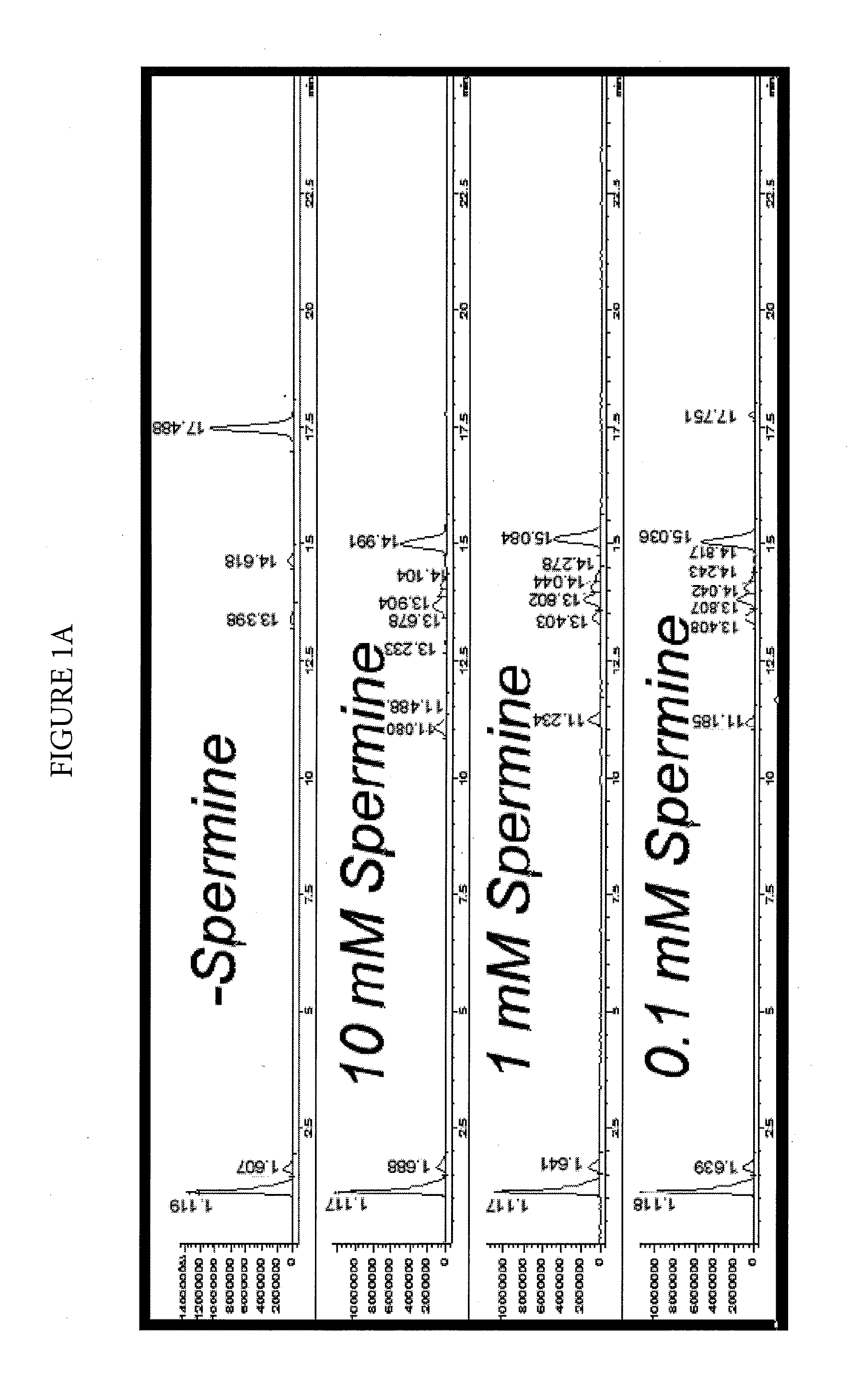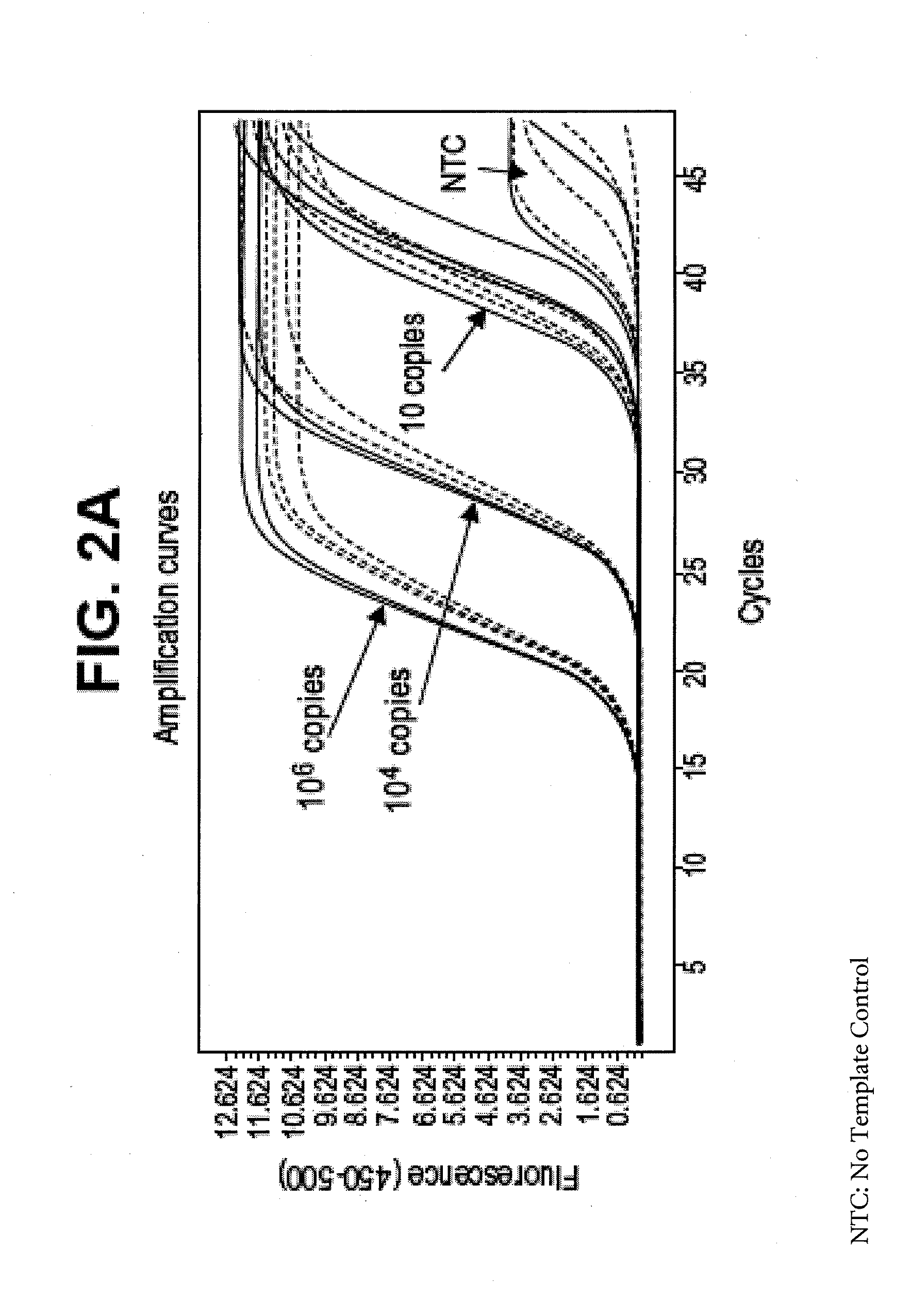Method for the prevention of carryover contamination in nucleic acid amplification technologies
a technology carryover, applied in the field of nucleic acid amplification methods, can solve the problems of persistent contamination, inefficiency of non-enzymatic degradation steps, no longer be eliminated, etc., and achieve the effect of improving carryover contamination control, simple, efficient, and not needing improvemen
- Summary
- Abstract
- Description
- Claims
- Application Information
AI Technical Summary
Benefits of technology
Problems solved by technology
Method used
Image
Examples
example 1
Effect of Spermine on Degradation of an Oligonucleotide Having Abasic Sites
[0046]The deoxyuracil-containing DNA oligonucleotide of SEQ ID NO: 1:
[0047]
5′-TTTGCATGGCTGCUTGATGTCCCCCCACT-3′
was incubated in a solution prepared by combining a 10 μL aliquot of a 100 μM solution with 10 μL of a mock RT-PCR mastermix solution. The mock mastermix solution contained 50-mM tricine (pH 8.3), 90 mM potassium acetate, 200 μM each of dATP, dCTP and dGTP, 400 μM dUTP, 4 mM manganese acetate, 5% DMSO, and 5% glycerol. Additionally, the reaction mixture contained 2.5 μL of water or spermine solution at the appropriate concentration, and 2 μL of 4 units / μL UNG. The incubations were for 30 minutes at 50° C., with or without a further heat spike step at 95° C. for two minutes. The reactions were analyzed by HPLC-MS using an Agilent 1100 MSD detection system with an electrospray ionization source. The mass-spectrometry (MS) data (not shown) clearly showed that under all conditions, the removal of uracil w...
example 2
Amplification of DNA and RNA in the Presence of Spermine
[0048]For DNA, a polymerase chain reaction was performed to amplify a 241-bp DNA template (Target 5, 20% dT for double-stranded DNA). The reaction mixture contained 40 units of ZO5 DNA polymerase, 50 mM tricine (pH 8.3), 90 mM potassium acetate, 200 μM each of dATP, dCTP and dGTP, 400 μM dUTP, 0.1 μM of each upstream and downstream primers, 4 mM manganese acetate, 5% DMSO, and 5% glycerol, 2 μM SYTO-16 intercalating dye, and optionally, 100 μM spermine. Amplification was performed in a Roche LightCycler 480 instrument using the following temperature profile 50° C. for 5 min (UNG step), two cycles of 94° C. for 15 sec (denaturation) and 59° C. for 40 sec (annealing and extension), 48 cycles of 91° C. (denaturation) and 59° C. for 40 sec (annealing and extension). The fluorescence data was collected during the anneal / extend steps of the last 48 cycles using a 483 nm / 533 nm filter combination for excitation and emission respective...
example 3
Efficiency of Amplification in the Presence of dUTP Only or a Combination of dUTP and dTTP
[0052]A reverse transcription polymerase chain reaction (RT-PCR) was performed to amplify 100,000 copies of a 141-nt RNA template (Target 2 from Table 1). This target has a very low dU content. The corresponding double-stranded DNA has 23% dT (Table 1). When the amplification is conducted in the presence of both dTTP and dUTP, the dU content of the DNA amplicon would be even lower. The reaction mixture included 0.5 M betaine, pH 6.3; 68 mM potassium acetate, pH 7.0; 2.8% glycerol; 3 mM manganese acetate, pH 6.1; 0.07% sodium azide; 5% DMSO; 50 mM tricine, pH 8.3; 0.3 mM each dATP, dCTP and dGTP; 0.5 mM dUTP; and where indicated, 0.05 mM dTTP; 40 units ZO5 DNA polymerase; 0.2 μM aptamer 0.2 μM each forward and reverse primer and 0.1 μM probe. The temperature profile was: 94° C. for 30 sec, 58° C. for 30 min (reverse transcription), five cycles of 95° C. for 15 sec and 59° C. for 21 sec, further ...
PUM
| Property | Measurement | Unit |
|---|---|---|
| temperature | aaaaa | aaaaa |
| temperature | aaaaa | aaaaa |
| temperature | aaaaa | aaaaa |
Abstract
Description
Claims
Application Information
 Login to View More
Login to View More - R&D
- Intellectual Property
- Life Sciences
- Materials
- Tech Scout
- Unparalleled Data Quality
- Higher Quality Content
- 60% Fewer Hallucinations
Browse by: Latest US Patents, China's latest patents, Technical Efficacy Thesaurus, Application Domain, Technology Topic, Popular Technical Reports.
© 2025 PatSnap. All rights reserved.Legal|Privacy policy|Modern Slavery Act Transparency Statement|Sitemap|About US| Contact US: help@patsnap.com



